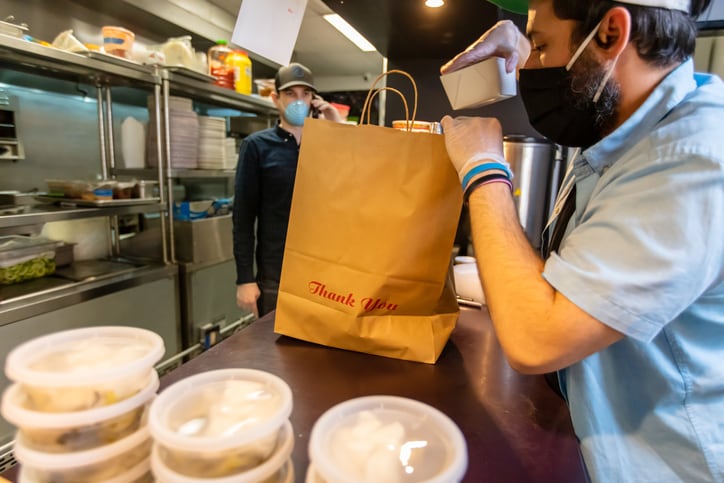A new report on UK trends from AI-powered food intelligence start-up Tastewise claims consumer interest in convenience / on-the-go spiked by 75% in the three first months of the pandemic (April - June) and has remained pretty stable ever since. Many restaurants, however, have stopped on-the-go solutions, which could be disadvantageous.
On-the-go “has become a standard need to fulfil for the UK consumers,” Tastewise VP Marketing Ron Harnik told FoodNavigator. However, it seems that menus have only increased their on-the-go services during the pandemic, he said, meaning food service businesses risk “missing out on a high, stable consumer demand that is still relevant today”.
The graph below shows the huge spike as foodservice sector offered more on-the-go and takeaway options. That spike dipped, but demand stayed the same. “Those that reverted back to pre-Covid menus could mean they're missing out on an opportunity,” said Harnik.
Tastewise’s analysis – based on real-time scanning of millions of social media interactions, online recipes and restaurant menus* – revealed a Covid ‘slingshot’ effect: where interest in all those trends accelerated by the pandemic such as stress relief, comfort food, immunity and gut health has slowed as the crisis has ebbed, but has still remained on a higher plateau than before.
For example, today’s restaurant industry is seeing a +115% steady increase in menu mentions that explicitly name health benefits since right before pandemic hit (ie since February 2020), the report deep dive revealed. Consumers are more concerned about health around new years and their focus fades throughout the year, however, the pandemic has kept health top of mind for consumers as the spike in January was 49% higher than the previous January (pre-Covid). This indicates that health is becoming even more so ingrained in consumer interest, even if it’s decreasing in popularity at the moment - it shows seasonal resilience
Interest in immunity is 41% higher than pre-Covid rates of interest, with a significant focus on Gut Health (35% of immunity conversations focus on gut health).
Interest in stress-relieving food and beverage is also +22% higher than pre-pandemic levels. “The biggest take away is that the food service sector should not dismiss the effects of Covid after they are over,” Harnik observed. “The need to offer on-to-go versions of everything and good delivery are lingering. They can still be capitalised on by most food service establishments.”
Gourmet eating back on the menu
One trend that is returning among out-of-home eaters is ‘attractive’ (8%, increasing +7% YoY), partnered with ‘gourmet’ (3%, growing +20% YoY) equalling a return to experiential eating as pandemic conditions change.
“It's not just about the dish itself that you eat but the setting that you eat it and the experience you're having while you eat it,” Harnik said.
This is something the company sees popping up across various different trends. For example, many alternative protein and meat alternative brands have begun tailoring products for barbeques.
Also in the plant-based realm, the report further revealed that sustainability is no longer the primary factor for consumers opting for meat-free products. Personal health accounts for 17% of vegan conversations, it revealed. Animal rights only feature in 7%; sustainability only in 3%. In other words: UK consumers are more than 2x more likely to eat vegan for personal health reasons than planetary health reasons.
The analysis also revealed a new rising diet in the UK: the ‘Fast 800’, a version of intermittent fasting, created by the doctor and television journalist Dr Michael Mosley. Conservations about the diet are up 126% YoY, said Tastewise.
Tastewise's data was pulled from:
73,865 restaurant locations
38,879 restaurant menus
1,397,826 people
22,471,350 posts
~4,000,000 recipes





